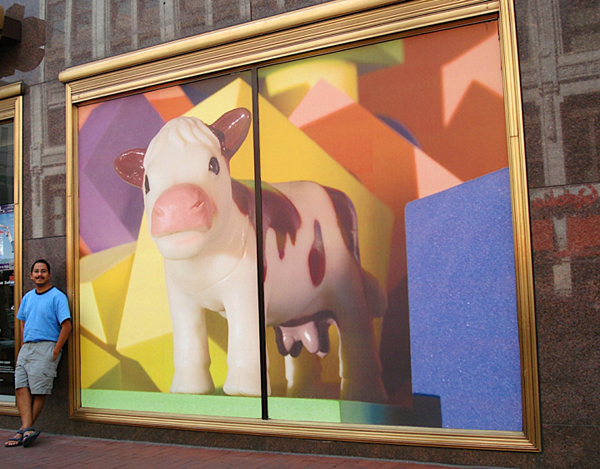300 mouths chewing on Indianapolis’ food issues today and in the future.
May 4, 2010, 6:00 to 8:00 p.m.
Eat, think and talk with neighbors, friends and new acquaintances at one of 15 different locally owned restaurants or community venues around the city. Over dinner, a facilitator will lead a conversation about “From local to global: How can we use Indiana’s strengths in agriculture and artisanal foods to position Indiana globally?” based on the book Caught in the Middle: America’s Heartland in the Age of Globalism by Richard Longworth. Each location will be limited to 20 people to encourage an intimate, yet fruitful conversation. Reserve your seat today.
Prices for a prix fixe menu may vary based on location. Free potluck options will also be available. This event is part of the IndyTalks series, a citywide collaboration dedicated to fostering a sense of community through respectful and creative civic dialogue. Facilitators include chefs, gardeners, self-professed foodies and local community leaders, such as Neal Brown, Michelle Griffith, Laura Henderson, Rob MacPherson, Michael Twyman and Bob Whitt. To reserve your spot, complete this form, and e-mail it to Gail@TheGoodsLife.com, or call Gail Payne at 317.985.5523. Reservations are limited, and are due by April 30.
Downtown
Indiana Humanities Council (Free/pitch-in)
1500 North Delaware Street Indianapolis, IN 46202
Facilitated by Rosemary Dorsa, Vice President for Partnerships and Strategic Initiatives, CICF, and Indiana Humanities Council board chair
The Indiana Humanities Council encourages Hoosiers to think, read and talk. How? By creating its own programs, such as Community Workshops, Evenings at the House and Novel Conversations; by providing grants for humanities programs throughout the state; and by providing a space—physically and digitally—for people to connect and converse.
R Bistro ($50/person)
888 Massachusetts Avenue Indianapolis, IN 46204-1633
Facilitator: Erin Kelley, Public Programs Coordinator, Indiana Historical Society
Read R Bistro reviews from IndyEthnicFood.com here
888 Massachusetts Avenue Indianapolis, IN 46204-1633
Facilitator: Erin Kelley, Public Programs Coordinator, Indiana Historical Society
Read R Bistro reviews from IndyEthnicFood.com here
Zing ($30/person)
543 Indiana Avenue Indianapolis, IN 46202
Host: Michael Twyman, program officer, Nina Mason Pulliam Charitable Trust
Read reviews of Zing from IndyEthnicFood.com here
Chef's Academy ($40/person)
Bob Whitt, Director, White River State Park
North
St. Luke's Methodist Church (Free/pitch-in)
100 West 86th Street Indianapolis, IN 46260-2316
Host: Cassie Stockcamp, President, Athenaeum Foundation
Recess Restaurant ($50/person)
Host: Michelle Griffith, Community Volunteer
Read reviews of Recess from NUVO here
South
University of Indianapolis (Free/pitch-in)
1400 East Hanna Avenue • Indianapolis, Indiana 46227
Host: Christine Beckman, director, conference and scheduling, University of Indianapolis
Santorini's Greek Kitchen ($25/person)
Host: Neal Brown, owner, Pizzology
Read reviews of Santorini's from IndyEthnicFood.com here
911 North State Road 135, Greenwood, IN 46142
Host: Pam Blevins Hinkle, director, Spirit & Place festival
Read reviews of Stone Creek at IndyEthnicFood.com here
East
John H. Boner Community Center (Free/pitch-in)
2236 East 10th Street Indianapolis, IN 46201-2098
Laura Henderson, market master, Indy Winter Farmers' Market
Legend-Classic Irvington Cafe ($35/person)
5614 East Washington Street Indianapolis, IN 46219
Host: Rob MacPherson, Vice President for Development, Central Indiana Community Foundation
Host: Rob MacPherson, Vice President for Development, Central Indiana Community Foundation
Irvington echoes throughout Indianapolis as the Sleepy Hollow of the Eastside. Historic houses, winding brick roads, and old magic meld together to form a community dripping with stories and legends. The Benton House and Butler University, the Irving Theatre, the D.C. Stevenson House, Ellenberger Park, and the circles; all are part of the history and mystery of Irvington.
The Loop Bar and Grille ($25/person)
8220 Brookville Road Indianapolis, IN 46239
Host still a mystery
West
Jewish Community Center (Free/pitch-in)
6701 Hoover Road Indianapolis, IN 46260
Host: Patti Dorson, Community Volunteer
Rick's Cafe Boatyard ($50/person)
Todd Jameson, owner, Balanced Harvest Farms, president, Slow Food Indy
An Indianapolis icon, Rick's is a palatial full-service restaurant and bar that serves superb quality coupled with service excellence. Winning multiple awards, including best crab cakes at Zoobilation 2009, we offer something for everyone!
Dawson's on Main (app. $25/person)
1464 Main Street Indianapolis, IN 46224-6526
Host still to be determined
Read Reid Duffy's review of Dawson on Main here























